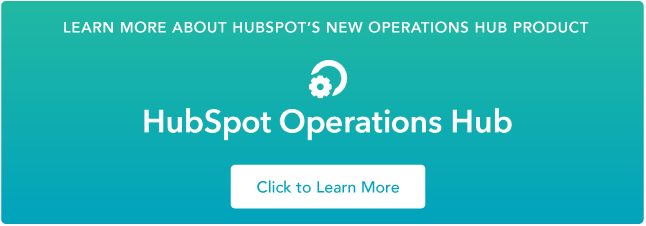At first glance, the terms 'data' and 'information' seem synonymous. However, when comparing data vs information, you'll quickly realize several intricacies that establish these two as disparate concepts.

So, what is the difference between data and information? While data refers to individual statistics or facts, information is data with context, organization, and purpose.
Learn More About HubSpot's Operations Hub Software
In this post, we're doing a deep dive on data vs information to help you better understand what each means and how they can help your business reach its goals. You'll also learn more about the importance of an effective data management strategy.
What is Data?
Data is raw statistics and facts collected for either analysis or reference. Because data lacks context, a piece of data isn't impactful. You can store data in an electronic format. From there, the raw data gets processed into information. Keep in mind that there's another definition of data, too — in the context of computing, 'data' refers to information translated into a form suitable for processing or movement.
You might be wondering how your business can collect data. The answer is that it varies. Your website can play a role in collecting data, such as through forms. But remember that data varies significantly — interactions with customers, providers, leads, and employees can all prove valuable in data collection.
That's where customer relationship management (CRM) comes into the picture. One way to ensure your company appropriately manages customer and lead data is by centralizing them in a CRM. Other software in the company's tech stack can enrich it from there.
Qualitative Data vs Quantitative Data
Keep in mind that there are two forms of data: qualitative and quantitative. Understanding the critical differences between the two can help you better comprehend their unique merits. While qualitative data is related to measuring the quality of something, quantitative connects directly to quantity. For instance, if you have a form on your website that asks ‘how are we doing?’ your visitors’ responses are qualitative data. The number of visitors that fill out the form, however, is quantitative.

What is information?
The most distinguishable difference between data and information is that information offers context, thanks to interpreting, processing, and organizing. The transformation from raw data to information is impactful because it can influence decisions.
If you're curious about the role information plays in your business, keep in mind how vital it is for those in a decision-making role to access reliable, relevant information. Of course, information is only as good as its quality — that's why accuracy and consistency are vital.
What is the difference between data and information?
- Data is a group of facts or statistics, whereas information offers context.
- Your information depends on your data, but not vice versa.
- Organization is key to information; data is unorganized.
- Data doesn't inherently have meaning. Only when it's analyzed does it offer purpose — and become information.
- Data doesn't offer a clear enough picture to make decisions, but because it has context, information does.
- Data is usually presented numerically, whereas information is often presented through words.
How does data become information?
In his book The Signal and the Noise, statistician Nate Silver writes, "The numbers have no way of speaking for themselves. We speak for them. We imbue them with meaning."
Keep this in mind when considering how data can transform into information. There are two primary facets of turning data into information. These include context and interpretation. In the absence of these, raw data is simply facts and figures — interesting but not actionable.
So, how does data become information? There are a few possible ways.
- Processing — This includes collecting, recording, organizing, and storing your information (such as in your CRM for safekeeping)
- Interpreting — This involves the process of making sense of facts and statistics. Then, giving them context to become meaningful in a business context.
- Organizing — It's essential to store data to enable your company to use it to make decisions. You can do this, for example, by syncing it with other apps.
Once your information has an application or use, it then becomes knowledge. And knowledge can have a direct influence on your organization's performance.

What are the best practices for high-quality data and information?
Quality data is a must-have to develop reliable, accurate insights into your business. The most effective way to ensure this is by optimizing each stage of the data lifecycle in your company. This can include taking steps such as:
- Storing data securely and ethically.
- Capturing truthful and reliable data in a standardized format.
- Maintaining data by validating and enriching it.
- Using structured data to make your customers’ lives easier and to optimize your site.
- Have your applications in sync. Doing so provides a complete overview of your data, regardless of the application where it was collected.
- Using your data efficiently to turn it into reliable information that influences decisions.
- Cleaning outdated or unreliable data.
- Formatting data to make it more searchable, usable, and readable.
Once you have high-quality data synced between your apps, you can optimize the information collected from it. That can include using automated data reporting that's transparent to key people in your business and offers meaningful insights. Remember that if the information isn't timely and relevant, it isn't worthwhile for your business to collect.
Data vs Information Examples in a Business Context
Now that you understand the disparity between these two concepts, it's helpful to evaluate data vs information examples in a practical setting. Here are some tangible examples of what data and information look like in practice.
Examples of Data
- The number of website visitors in a given month (ex: July)
- The time and date of a purchase from your ecommerce shop
- A customer subscription amount
Examples of Information
- (555)555-5555 as a phone number
- Having an understanding that organic traffic is increasing faster than direct traffic to your site
- Identifying the time of day the most transactions occur in your ecommerce shop
- The average annual contract value (ACV) of account subscription agreements
How can businesses harness the power of data and information?
So, where do data and information come into the picture? Truthfully, the answer is: everywhere. When your organization prioritizes the collection of data and its interpretation and application, you experience various benefits. It's never enough to rely on instinct when measuring the performance and health of a business. Instead, it would be best if you backed up decisions with quality data and actionable information.
For instance, you might be collecting data about how long people are spending on a specific page of your website before bouncing. You could gain a more robust understanding of why that may be through interpretation and organization. Then, you can act appropriately to rectify the issue if there is one.
However, if you're going to use data and information to impact business decisions, be mindful that it needs to be high-quality. If no one regularly monitors data quality, using it in decision-making can have an adverse influence. You should also avoid a data silo at all costs — data is at its best when it is accessible.
Make the most of data and information in your business.
Knowing the difference between data and information is the first step. Now, you can pay attention to how your business uses each and make adjustments if necessary. Focusing on the journey from raw, unprocessed data to relevant information with clear use is valuable and essential for any business.
Start by collecting high-quality data you can trust, sync standardized and enriched data between your apps, and turn it into transparent information that positively impacts your business and customers. This could kick start an evolution of how your company uses data and information.

